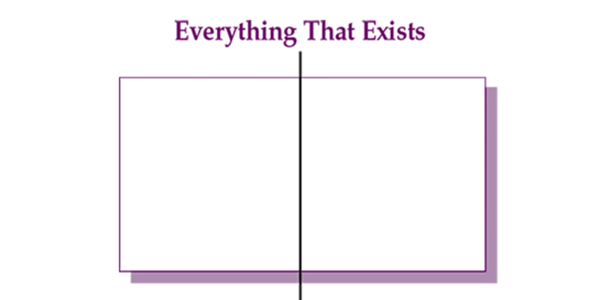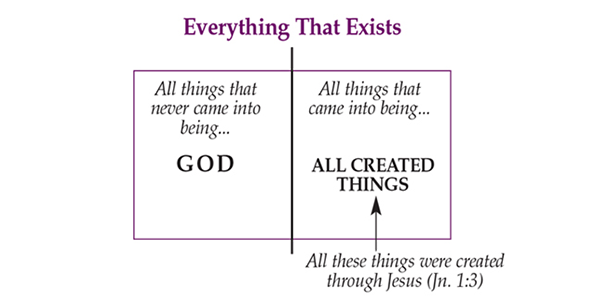Few doctrines of the Christian faith are as awkward as the Trinity, yet few are as important to understand and affirm. Get the basic nature of God wrong and much of what follows theologically will falter, being built on the wrong foundation. For that reason, I have devoted two issues of Solid Ground to the topic. My broad goal is to make a clear case for God’s Triune nature with a particular focus on the deity of Christ.
In the first installment,[i] I emphasized four things: the significance of the Trinity, the problem of the Trinity, the definition of the Trinity, and the alleged contradiction of the Trinity. My basic thesis: The Trinity is not a problem, but a solution. It’s the only way of understanding God that is consistent with His own self-revelation in both Testaments. Without it, the biblical record deteriorates into contradiction.
In this second installment, I want to center on the biblical fact of the Trinity[ii] by making a scriptural case for the unique deity of Christ. I won’t deal here with the deity of the Spirit, not because the third person of the Trinity has second-class status, but rather as a practical concern.
That the Father is God is not controversial, biblically. The deity of Christ is the issue most fiercely challenged and has historically been the center of the theological controversy. Once we’ve established the second person of the Godhead, adding another is easy if the Scripture warrants it for the same reasons it warrants belief in the deity of Christ.
My method is simple: provide clear scriptural support for each element that is essential to the definition of the Trinity as it applies to the person of Christ.[iii] There are three components. One, there is only one God. Two, Jesus is a distinct person from the Father. Three, Jesus is fully God. We know this because Jesus is called God, He possesses divine attributes, and He exercises divine privileges.
One thing I will not do is invite you to “picture” the Trinity by reducing it to an illustration. There are built-in problems with any attempts to visualize the Godhead in this way.
One, illustrations appeal to faculties that simply are not capable of helping us. God’s nature cannot be captured in an image (indeed, the 2nd commandment forbids it). Second, most illustrations depict a heretical notion of the Trinity (modalism, for example).[iv] Third, illustrations risk making the Trinity credible because it’s visual, not because it’s revealed. We know God’s nature because He’s told us about Himself. Therefore, my appeal will be entirely to His Word.
Hints of Promise
The idea that God Himself would come to the earth was hinted at in the teachings of the ancient Hebrew prophets.
Micah told of an eternal One being born in Bethlehem: “His goings forth are from long ago, from the days of eternity” (Micah 5:2). Isaiah said a child born of a virgin would be called God: “...you shall call His name Immanuel” [lit. “God with us”] (Is. 7:14), and “His name will be called...Mighty God[v]...Eternal Father” (Is. 9:6 ). Jeremiah added:
“Behold the days are coming,” declares the Lord, “when I shall raise up for David a righteous Branch.... And this is His name by which He will be called, ‘The Lord our righteousness’” (Jer. 23:5–6).
The prophet Malachi told of a future messenger who would declare God’s arrival to earth: “Behold I am going to send My messenger, and he will clear the way before Me” (Mal. 3:1). Isaiah said that messenger would be a voice calling, “Clear the way for the Lord in the wilderness. Make smooth in the desert a highway for our God” (Is. 40:3). Luke identifies John the Baptist as that voice (Lk. 3:4–6) who came to bear witness to Jesus: “I have seen, and have borne witness that this is the Son of God” (Jn. 1:34).[vi]
These are mere hints, though, not the kind of clear statements needed to establish our doctrine. Instead, the case for the deity of Christ rests on more explicit textual evidence showing that Scripture teaches, 1) there is only one God, 2) Jesus and the Father are personally distinct, and 3) Jesus shares the Father’s Divine nature.
There Is Only One God
The unmistakable teaching of the Bible is there is only one who is God in essence. This foundational element of Hebrew theology is found in Deut. 6:4, the great Sh’ma Yisrael: “Hear, O Israel! The Lord is our God, the Lord is one!” Isaiah also speaks with clarity that there is no God but one:
“You are My witnesses,” declares the Lord, “and My servant whom I have chosen, in order that you may know and believe Me, and understand that I am He. Before Me there was no God formed, and there will be none after Me.” (Is. 43:10)
“Thus says the Lord, the King of Israel and his Redeemer, the Lord of hosts: ‘I am the first and I am the last, and there is no God besides Me’” (Is. 44:6).
“I am the Lord, and there is no other; besides Me there is no God” (Is. 45:5).
“And there is no other God besides Me, a righteous God and a Savior; there is none except Me. Turn to Me, and be saved, all the ends of the earth, for I am God, and there is no other” [vii] (Is. 45:21b, 22).
Since there is no true God but Yahweh, all other so-called “gods”—idols, spirit beings, etc.—are false gods:
We know that there is no such thing as an idol in the world, and that there is no God but one. For even if there are so-called gods whether in heaven or on earth, as indeed there are many gods and many lords, yet for us there is but one God, the Father, from whom are all things, and we exist for Him, and one Lord, Jesus Christ, by whom are all things, and we exist through Him (1 Cor. 8:4b–6).
Jesus Is Distinct from the Father
Jesus is a separate person from the Father, not merely a different “mode” of God (i.e., God was in the “Father” mode in the Old Testament and the “son” mode in the Gospels, the way a woman is in “mother” mode at home and “worker” mode at the office). How do we know? From the many instances in Scripture where Jesus interacts with the Father in personal ways, clearly distinguishing each from the other.
Jesus’ baptism is one example. Both the Father and the Son are present, but one speaks and the other is silent. Note Luke 3:21–22:
Now when all the people were baptized, Jesus was also baptized, and while He was praying, heaven was opened, and the Holy Spirit descended upon Him in bodily form like a dove, and a voice came out of heaven, “You are My beloved Son, in You I am well-pleased.”
John 3:16 famously states that God gave His Son. The first gave the second. In John 17, Jesus prays to the Father. Jesus was talking to another, not to Himself. Later that night in Gethsemane, Jesus submits Himself to the Father’s plan with, “Not as I will, but as You will” (Matt. 26:39). A person cannot surrender to himself, but only to another party. Paul tells Timothy, “There is one God, and one mediator also between God and men, the man Christ Jesus” (1 Tim. 2:5). A mediator stands between two parties and is distinct from each.
Jesus Is Fully God
Three lines of scriptural evidence demonstrate Christ’s Divinity: Jesus was called God, Jesus had divine attributes, and Jesus exercised divine prerogatives.
The Scripture is replete with examples of Jesus being called or equated with God in unmistakable terms, and Jesus Himself made the claim.
In the beginning was the Word, and the Word was with God, and the Word was God.... And the Word became flesh, and dwelt among us, and we beheld His glory... (Jn. 1:1,14 ).
...from whom is the Christ according to the flesh, who is over all, God blessed forever (Rom. 9:5).
God our Savior.... Jesus our Savior (Titus 1:3–4).
God our Savior...our great God and Savior, Jesus Christ... (Titus 2:10, 13).
He is the image of the invisible God.... For in Him all the fullness of Deity dwells in bodily form (Col. 1:15, 2:9).
And He is the radiance of His glory and the exact representation of His nature, and upholds all things by the word of His power (Heb. 1:3).
Jesus said to them, “Truly, truly, I say to you, before Abraham was born, I am” (Jn. 8:58).
And note this stunning statement in Acts 20:28: “Be on guard for yourselves and for all the flock, among which the Holy Spirit has made you overseers, to shepherd the church of God which He purchased with His own blood.” When did God bleed? When He was crucified on a Roman cross.
Jesus also had divine attributes. First, notice Isaiah’s unequivocal statement about the ultimate source of all things in Is. 44:24:
Thus says the Lord, your Redeemer, and the one who formed you from the womb, “I, the Lord, am the maker of all things, stretching out the heavens by Myself, and spreading out the earth all alone.”
Yet at the same time, the New Testament teaches that Jesus created all things. The point is made in a couple of places, but none more clear than John 1:3, providing one of the most decisive biblical evidences for the deity of Christ.
The Irrefutable Argument
The opening verses of John’s Gospel offer a scriptural proof for Christ’s divinity that is so simple you can sketch it out on a napkin from memory the next time a missionary knocks on your door.
John 1:3 states, “All things came into being through Him [the Word], and apart from Him nothing came into being that has come into being.”[viii] Have your visitor read the verse out loud. Then take out a piece of paper and draw a large box, explaining that the box represents everything that exists. Run a line right through the middle of the box, dividing everything that exists into two categories. It will look like this:

On the left side write, “all things that never came into being,” that is, all things that exist, but have never been created. Ask your friend, “What goes in that side?” If he says “God,” he got the right answer. God alone is eternal and uncreated. Put the word “God” in the left-hand side of your box.
Label the right side “all things that came into being,” that is, all created things (write that in, too). According to John 1:3, everything on this side was created through Jesus. Ask your friend if he understands that. Now write “created through Jesus” outside the box and run an arrow to the right side. Your box should now look like this:

Take a moment to point out to your guest how this illustration is structured. The larger box includes everything there is, was, or ever will be. Every existing thing falls into one—and only one—of those two categories: created or not created. Simple.
Next, take a coin from your pocket and tell your guest the coin represents Jesus. Hand him the coin and ask him to place the Jesus coin on the side where He belongs. This is where things get interesting.
The first impulse of a Jehovah’s Witness is to place Jesus in the category of created things because that’s what his theology dictates. But the verse doesn’t allow that option. John says, “All things came into being by Him [or through Him], and apart from Him nothing came into being that has come into being,” not even one thing.
John’s meaning is unequivocal and unmistakable: Everything that ever came into being owes its existence to Jesus, who caused it all to happen. If Jesus caused all created things to come into existence, then He must have existed before all created things came into existence. Therefore, the Word could not have been created. If He was, He would have created Himself, which is impossible.
The coin cannot be placed on the right side, and it can’t be placed anywhere on the paper outside the larger box (which he may attempt), since there is nothing out there. These categories are all-encompassing and mutually exclusive; there’s no “place” outside to put Him. Everything goes in one side of the larger box or the other.
If Jesus can’t be placed in the right side with created things, then He must go in the left side with uncreated things. Jesus was the uncreated Creator. Therefore, Jesus is God.
Counters that Jesus is distinguished from the Father in other passages (as when He prays to the Father in John 17) merely reinforce our defense of the Trinity. Agreed, Jesus is not the Father. Jesus can talk to the Father because each is a separate person, but as Creator, Jesus shares the same divine essence as the Father. That was John’s point, which is why he calls the Word “God” in John 1:1.
The final evidence that Jesus is God is that He exercises prerogatives reserved for God alone. The most vivid example is Jesus receiving worship.
“Bowing Down”
The word proskuneo (translated “worship,” or “bow down”) occurs 59 times in the New Testament in five different contexts. Clearly, there is a sense where someone could “bow down” in homage or obeisance in a way that does not entail worship. This happened with Jesus, for example, when the leper came to Him for healing (Matt. 8:2).
However, there is a type of “bowing down” reserved for God alone. When John “fell at his feet to worship” [proskuneo] the angel in Rev. 22:8, the angel rebuked him. When the gentile Cornelius did the same thing with Peter in Acts 10:25, he was likewise corrected. How were these two instances of proskuneo different from mere homage or respect?
Here’s the difference. Cornelius could not fall at Peter’s feet and then bow down. He was already down. John didn’t fall down at the angel’s feet and then bow down. He was already down. Whenever the phrase “fall down” is followed by proskuneo, that word cannot simply mean “bow down,” since the person is already down.
Remember the devil’s words at Jesus’ temptation in Matthew 4:9: “And he said to Him, ‘All these things will I give You, if You fall down and worship me.’” Jesus said to him, “Be gone, Satan! For it is written, ‘You shall worship the Lord your God, and serve Him only.’” This was the same pattern as with John in Revelation and Cornelius in Acts.
So, do we ever see that pattern—a “falling down” followed by the word proskuneo—with others toward Jesus? Only the context can tell us. I’ll give you two examples.
In the birth narratives, the wise men asked, “Where is He who has been born King of the Jews? For we saw His star in the east, and have come to worship Him” (Matt. 2:2). When they found Him, “after coming into the house they saw the Child with Mary His mother, and they fell to the ground and worshiped Him” (Matt. 2:11).
After Jesus’ resurrection, Jesus met the women at the tomb. After He greeted them, “they came up and took hold of His feet and worshiped Him” (Matt. 28:9). Notice that when the women take hold of Jesus’ feet, they are already down. When proskuneo is added once they are down, it can only mean worship.
Worship is reserved for God alone, yet clearly Jesus was worshiped as God.
God will also not share His glory: “Thus says the Lord God.... ‘I am the Lord, that is My name; I will not give My glory to another’” (Is. 42:5, 8). Yet Jesus claimed, “The Father...has given all judgment to the Son so that all will honor the Son even as they honor the Father” (Jn. 5:22–23). Peter made the same point: “Grow in the grace and knowledge of our Lord and Savior Jesus Christ. To Him be the glory, both now and to the day of eternity. Amen” (2 Pet. 3:18).
God Is... Jesus Is
There is yet another powerful line of scriptural evidence that Jesus is God: characteristics or privileges unique to God in the Old Testament are applied to Jesus in the New Testament. There are many examples of this. Here are a few:
“I have sworn by Myself...that to Me every knee will bow, every tongue will swear allegiance” (Is. 45:23).
“That at the name of Jesus every knee will bow...every tongue will confess that Jesus Christ is Lord...” (Phil. 2:10).
“I, even I, am the Lord; and there is no savior besides Me” (Is. 43:11).
“...by the righteousness of our God and Savior Jesus Christ” (2 Pet. 1:1).
“Is there any God besides Me, or is there any other Rock? I know of none” (Is. 44:8).
“All drank the same spiritual drink [in the wilderness], for they were drinking from a spiritual rock which followed them, and the rock was Christ” (1 Cor. 10:4).
“God said to Moses...say to the sons of Israel, ‘I AM has sent me to you’” (Ex. 3:14).
“Jesus said to them, ‘Truly, truly, I say to you, before Abraham was born, I AM’” (Jn. 8:58).
“Thus says the Lord, the King of Israel and his Redeemer, the Lord of hosts: ‘I am the first and I am the last, and there is no God besides Me’” (Is. 44:6).
“I am the first and the last, and the living One, and I was dead, and behold I am alive forevermore” (Rev. 1:17–18).
The Glorious Solution
In the final analysis, the Trinity is a mystery. It’s a revealed doctrine, not an invented one. Our job was to find out what the Bible teaches, not unravel the mystery. We did that.
If there is only one God, and if the Father and Son and the Spirit are distinct in personal ways, and if are all affirmed to be God in Scripture, then the only explanation that makes sense of God’s own self-revelation is the Trinity.
The Trinity is the ground of God’s love. It is the foundation of the work of the Cross. It is the basis of Christian community. It encompasses all aspects of our salvation.
Is the Trinity a problem? No. It’s a solution—a magnificent, marvelous, glorious, solution.
[i] Available in enhanced digital form at str.org.
[ii] For an engaging treatment of the Trinity’s significance, see Fred Sanders’s The Deep Things of God (Wheaton: Crossway, 2010).
[iii] The exact same approach can be used to establish the Deity of the Spirit.
[iv] Find a clever characterization of this problem at https://m.youtube.com/watch?v=.
[v] Note the same language in Jer. 32:17–18: “Ah Lord God! Behold, You have made the heavens and the earth by Your great power.... O great and mighty God.”
[vi] Note also, “This is He on behalf of whom I said, ‘After me comes a Man who has a higher rank than I, for He existed before me’” (Jn. 1:30), even though John was born six months before Jesus.
[vii] These passages, favorites of Jehovah’s Witnesses, also say God is the only Lord and the only Savior, the first and the last, all characteristics applied to Jesus in the New Testament, as we’ll see.
[viii] The Jehovah’s Witness’s New World Translation has virtually the same wording in this verse, so you won’t run into any difficulty here.

